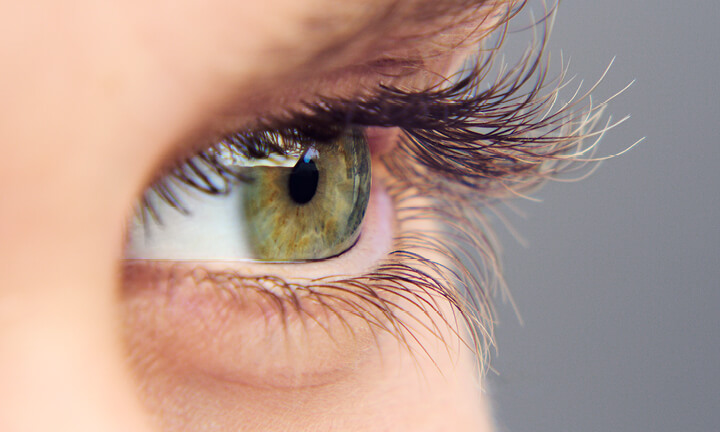
As screen time increases, here’s how to protect your eyes.
In today’s environment, personal computers, laptops, tablets, phones, and other digital devices have become increasingly important in all our lives. Work meetings on Zoom and Skype, binge sessions on streaming platforms, distance learning, and digital meetups with family and friends are now an everyday occurrence. We’re all doing our best to keep ourselves productive, engaged, and, above all, grounded, during these precarious times. But how do our eyes cope with the changes, especially when they seem to be glued to one or another screen for hours and hours on end? Taking a few simple steps each day can help save your eye health from the ill effects of extended digital screen exposure.
Increased screen time puts a strain on my eyes? Why? Causes of computer vision syndrome
Computer vision syndrome (CVS), or digital eye strain, as it’s also known, results when you spend extended periods using and looking at devices with digital displays. There are several reasons for this. First, and probably most commonly known, a major portion of the visible light that many screen types produce falls within the blue light range. When blue light enters your eyes, it scatters, requiring additional effort to refocus and see properly.
What’s more, most screen types combine pixels—no matter how small and fine, or subtle to your eye—of different colors that contrast to create the images on your screen. Even if you do not consciously notice the difference, the text on your screen is less precise and sharp as the text printed in traditional media, like books, magazines, and newspapers. Text on screens also tends to have a lower contrast between the background and the actual text. Making matters worse, when your screen is made from glass or there’s a lot of light in the room, you may experience a reflection or glare that you must “look past” to see your work. When your eyes try to compensate for these added difficulties, they must work harder to keep everything in focus, eventually overexerting them.
Other common causes of digital eye strain include:
Uncorrected vision problems—don’t underestimate the underlying contribution of other vision problems. If your eyes already have trouble focusing on nearby objects, then CVS might be intensified. Things like astigmatism, farsightedness, presbyopia resulting from aging, or poor eye coordination abilities all might be making your CVS worse if they are undiagnosed or your prescription is not up to date.
Improper lighting and contrast—when the brightness of your screen does not match the general brightness of your environment, then this can also contribute to digital eye strain. Every time you look away and back to your screen, the contrast in lighting forces your eyes to readjust. The lower the contrast, the less readjusting necessary.
Improper screen position, screen distance, and sitting posture—when objects are too close, it takes more effort for your eyes to focus on them. This principle applies to digital screens as well. Furthermore, when your screen is far below your line of sight—as is oftentimes the case with handheld devices or laptops resting on a desk—the angles increase glare and you must crane your neck to see the screen properly.
Most common symptoms of computer vision syndrome
In focusing so much on digital text and images, with less than ideal viewing conditions, your eyes just naturally grow weary with the passage of a few hours. Any or all of the following symptoms may result:
- Eyestrain: discomfort and aches
- Dry and irritated eyes
- Headaches
- Neck, shoulder, and (less commonly) back pain
- Temporary blurred distance vision
- Temporary night vision difficulties
- Insomnia
If you notice that you are experiencing any of these symptoms following long periods in front of a screen, then you may have unaddressed troubles with computer vision syndrome.
Six strategies for reducing your screen time and your digital eye strain
- The 20-20-20 rule—eye care is easy: every 20 minutes, take 20 seconds to focus on an object that’s about 20 feet away. This gives your eyes a chance to focus on something different every so often, so they don’t become overworked. And as a general rule, don’t ever exceed more than two straight hours in front of a screen.
- Take breaks—even if you use digital devices consistently during your normal day-to-day work routine, how often are you usually taking breaks from your screen without even realizing it? At home, there are just less opportunities for some of the same natural breaks afforded to us at work to occur. Think about it: chance phone calls and conversations from clients and colleagues; getting up to go to the bathroom; scheduled in-person meetings and group work; snack, lunch, and coffee breaks; and all the short walks between all these things. Take the time during your new “home office” day to make these same kinds of breaks in your screen time a conscious part of your routine. Get up and go for a short walk; carefully craft the perfect cup of coffee; play with your kids for five or ten minutes; and so on. Whatever works for you to peel your eyes away from that digital space to give them their well-deserved breaks.
- Blink more—you might not believe it, but almost everybody blinks less while they are looking at a screen. Blinking is the most natural form of eye care—it keeps them lubricated. When you blink, you lock in moisture essential to naturally protect and soothe your eyes. Making a conscious effort to blink more while you work on a computer will reduce many of CVS’s symptoms, especially dry eye.
- Adjust lighting, posture, and the surroundings—do everything in your power to reduce glare and reflections on your screen. If it’s bright outside, then close the blinds and find a position in the room that doesn’t let the natural light directly reflect off your screen. Always try to adjust your display brightness to match the ambient surroundings in the room. That especially includes dimming the display significantly when the room is dark at night. Finally, your screen should be about two feet from your face and only slightly below eye level. Your back should be held straight while sitting; the angles of your elbows should be kept between 90 and 100 degrees; and your chair height should be such that your feet are flat on the floor, and your thighs are parallel to the floor.
- Stop using your devices before going to sleep—if you’ve had more trouble sleeping lately, and you haven’t had noticeably more stress in your life, then there’s another factor that might be at play: your screen time. Viewing a blue-light emitting display before bed might contribute to insomnia, by signaling to the brain to get active. This is because we experience more blue light during the daylight hours and it plays a part in our natural circadian rhythm regulation. Try to avoid digital devices two hours before bedtime (or at least one hour before if two is not possible).
- Get an eye exam—going to your eye doctor is one of the best ways to address CVS and support your eye health. He or she will give you a comprehensive eye exam and personal consultation. If you have any undiagnosed vision problems that are contributing to digital eye strain, then your eye doctor will correct them accordingly. Additionally, you may ask your optometrist how you might best address the symptoms you’re having, and he or she may even adjust your prescription or recommend a blue light reduction lens coating for your glasses to be better suited for digital screen use.
Although it’s clear that digital screens are here to stay around awhile, it doesn’t mean that the quality of your eye health must suffer as a result. By following these tips, and consulting with your eye doctor, you’ll have every chance of looking far beyond this time of crisis and uncertainty, with as much clarity as 20-20(-20) vision.
If you don’t have vision insurance, find out how VSP Individual Vision Plans can help you save on your next eye exam or pair of glasses.
Information received through VSP Vision Care's social media channels is for informational purposes only and does not constitute medical advice, medical recommendations, diagnosis or treatment. Always seek the advice of your physician or other qualified health provider with any questions you may have regarding a medical condition.
Your vision. Your way.
Not covered for vision? Get an individual plan, customized for you – including where you want to use it: at the doctor, in a retail location, or even online.

Are Glasses, Contacts, and Vision Premiums Tax Deductible?
Are Eyeglasses Tax Deductible? Many Americans are searching for ways to decrease their tax burden. Luckily, there are many little-known deductions ...

Tips for Finding the Right Reading Glasses
Sadly, the text in your books and on your screen were not printed in a new trendy “fuzzy format.” Your eyes, like most body parts, have ...

3 Reasons to Schedule an Eye Exam Today
Regularly scheduled eye exams are important, even if you already have perfect vision. Read our three reasons below why it might be a good idea to sc...
